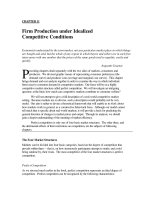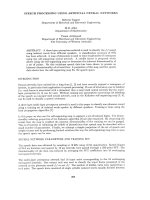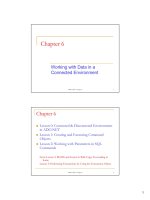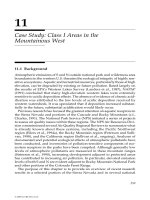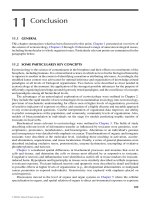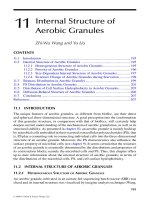chapter 11 pricing with market power
Bạn đang xem bản rút gọn của tài liệu. Xem và tải ngay bản đầy đủ của tài liệu tại đây (191.66 KB, 36 trang )
Chapter 11
Pricing with
Market Power
Topics to be Discussed
Capturing Consumer Surplus
Price Discrimination
Intertemporal Price Discrimination and
Peak-Load Pricing
The Two-Part Tariff
Chapter 11
Slide 2
Introduction
Pricing without market power (perfect
competition) is determined by market
supply and demand.
The individual producer must be able to
forecast the market and then
concentrate on managing production
(cost) to maximize profits.
Chapter 11
Slide 3
Introduction
Pricing with market power (imperfect
competition) requires the individual
producer to know much more about the
characteristics of demand as well as
manage production.
Chapter 11
Slide 4
Capturing Consumer Surplus
$/Q
Pmax
Between 0 and Q*, consumers
will pay more than
P*--consumer surplus (A).
A
P1
P*
B
P2
PC is the price
that would exist in
a perfectly competitive
market.
MC
PC
If price is raised above
P*, the firm will lose
sales and reduce profit.
D
Beyond Q*, price will
have to fall to create a
consumer surplus (B).
MR
Q*
Chapter 11
Quantity
Slide 5
Capturing Consumer Surplus
$/Q
Pmax
A
P1
•A: consumer surplus with P*
•B: P>MC & consumer would buy
at a lower price
•P1: less sales and profits
•P2 : increase sales & and reduce
revenue and profits
•PC: competitive price
P*
B
P2
MC
PC
D
MR
Q*
Chapter 11
Quantity
Slide 6
Capturing Consumer Surplus
$/Q
Pmax
Question
How can the firm
capture the consumer surplus
in A and sell profitably in B?
A
P1
P*
B
P2
MC
PC
Answer
Price discrimination
Two-part tariffs
D
MR
Q*
Chapter 11
Quantity
Slide 7
Capturing Consumer Surplus
Price discrimination is the charging of
different prices to different consumers
for similar goods.
Chapter 11
Slide 8
Price Discrimination
First Degree Price Discrimination
Charge
a separate price to each customer:
the maximum or reservation price they are
willing to pay.
Chapter 11
Slide 9
Additional Profit From Perfect FirstDegree Price Discrimination
$/Q
Pmax
Without price discrimination,
output is Q* and price is P*.
Variable profit is the area
between the MC & MR (yellow).
Consumer surplus is the area
above P* and between
0 and Q* output.
MC
P*
With perfect discrimination, each
consumer pays the maximum
price they are willing to pay.
PC
D = AR
Output expands to Q** and price
falls to PC where MC = MR = AR = D.
Profits increase by the area above MC
between old MR and D to output
Q** (purple)
MR
Q*
Chapter 11
Q**
Quantity
Slide
Additional Profit From Perfect FirstDegree Price Discrimination
$/Q
Pmax
Consumer surplus when a
single price P* is charged.
With perfect discrimination
• Each customer pays their
reservation price
•Profits increase
Variable profit when a
single price P* is charged.
MC
P*
Additional profit from
perfect price discrimination
PC
D = AR
MR
Q*
Q**
Quantity
Chapter 11
Slide
Additional Profit From Perfect FirstDegree Price Discrimination
Question
Why
would a producer have difficulty in
achieving first-degree price discrimination?
Answer
1) Too many customers (impractical)
2) Could not estimate the reservation
price for each customer
Chapter 11
Slide
Second-Degree Price Discrimination
Practice of charging different prices per
unit for different quantities of the same
good or service
Chapter 11
Slide
Second-Degree Price Discrimination
Second-degree price
discrimination is pricing
according to quantity
consumed--or in blocks.
$/Q
P1
Without discrimination: P = P0
and Q = Q0. With second-degree
discrimination there are three
prices P1, P2, and P3.
(e.g. electric utilities)
P0
P2
AC
P3
MC
D
MR
Q1
1st Block
Q0
Q2
Q3
2nd Block 3rd Block
Quantity
Second-Degree Price Discrimination
$/Q
Economies of scale permit:
•Increase consumer welfare
•Higher profits
P1
P0
P2
AC
P3
MC
D
MR
Q1
1st Block
Q0
Q2
Q3
2nd Block 3rd Block
Quantity
Price Discrimination
Third Degree Price Discrimination
1) Divides the market into two-groups.
2) Each group has its own demand
function.
Chapter 11
Slide
Third-Degree Price Discrimination
$/Q
Consumers are divided into
two groups, with separate
demand curves for each group.
MRT = MR1 + MR2
D2 = AR2
MRT
MR2
MR1
D1 = AR1
Quantity
Chapter 11
Slide
Third-Degree Price Discrimination
$/Q
MC = MR1 = MR2
P1
•QT: MC = MRT
•Group 1: P1Q1 ; more inelastic
•Group 2: P2Q2; more elastic
•MR1 = MR2 = MC
MC
P2
D2 = AR2
MRT
MR2
D1 = AR1
MR1
Q1
Q2
Chapter 11
QT
Quantity
Slide
Intertemporal Price
Discrimination and Peak-Load Pricing
Separating the Market With Time
Initial
release of a product, the demand is
inelastic
Book
Movie
Computer
Chapter 11
Slide
Intertemporal Price
Discrimination and Peak-Load Pricing
Separating the Market With Time
Once
this market has yielded a maximum
profit, firms lower the price to appeal to a
general market with a more elastic demand
Paper back books
Dollar Movies
Discount computers
Chapter 11
Slide
Intertemporal Price Discrimination
Consumers are divided
into groups over time.
Initially, demand is less
elastic resulting in a
price of P1 .
$/Q
P1
Over time, demand becomes
more elastic and price
is reduced to appeal to the
mass market.
P2
D2 = AR2
AC = MC
MR1
MR2
D1 = AR1
Q1
Chapter 11
Q2
Quantity
Slide
Intertemporal Price
Discrimination and Peak-Load Pricing
Peak-Load Pricing
Peak-Load Pricing
Demand for some products may peak at
particular times.
Rush
hour traffic
Electricity
Ski
- late summer afternoons
resorts on weekends
Chapter 11
Slide
Intertemporal Price
Discrimination and Peak-Load Pricing
Peak-Load Pricing
Peak-Load Pricing
Capacity restraints will also increase
MC.
Increased MR and MC would indicate a
higher price.
Chapter 11
Slide
Intertemporal Price
Discrimination and Peak-Load Pricing
Peak-Load Pricing
Peak-Load Pricing
MR is not equal for each market
because one market does not impact
the other market.
Chapter 11
Slide
Peak-Load Pricing
$/Q
MC
P1
Peak-load
price = P1 .
D1 = AR1
Off- load
price = P2 .
P2
MR1
D2 = AR2
MR2
Q2
Chapter 11
Q1
Quantity
Slide
